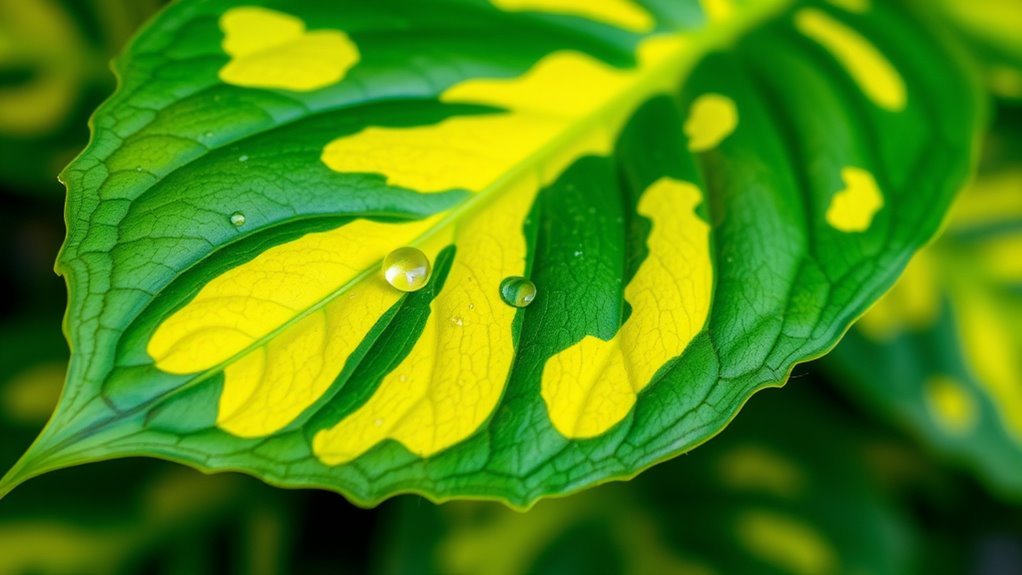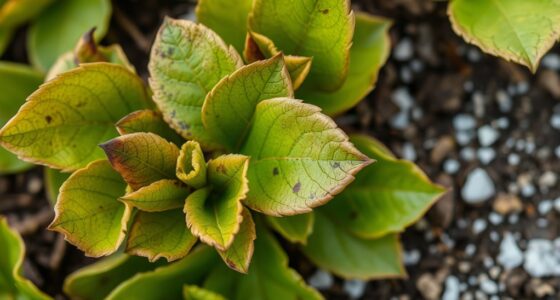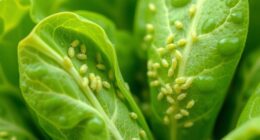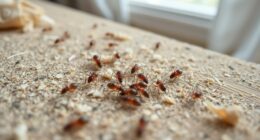Yellow leaves on your Scindapsus Pictus could result from overwatering, which causes root rot and soggy soil, or from nutrient deficiencies like nitrogen or iron shortages that lead to pale foliage. Check your watering schedule and soil moisture—dry soil suggests underwatering, while soggy soil points to overwatering. Also, consider if your plant’s getting enough nutrients. Keep exploring to learn how to diagnose and fix these common issues effectively.
Key Takeaways
- Uniform yellowing and soft leaves typically indicate overwatering, while uneven yellowing suggests nutrient deficiencies.
- Overwatering often causes soggy soil and root rot, whereas nutrient deficits are linked to specific leaf color patterns.
- Check soil moisture; consistently wet soil points to overwatering, dry soil suggests underwatering or nutrient issues.
- Nutrient deficiencies like nitrogen or magnesium usually cause yellowing in older leaves first.
- Proper diagnosis involves assessing watering habits, soil condition, and leaf pattern to distinguish between overwatering and nutrient deficits.
Recognizing the Signs of Overwatering in Your Plant
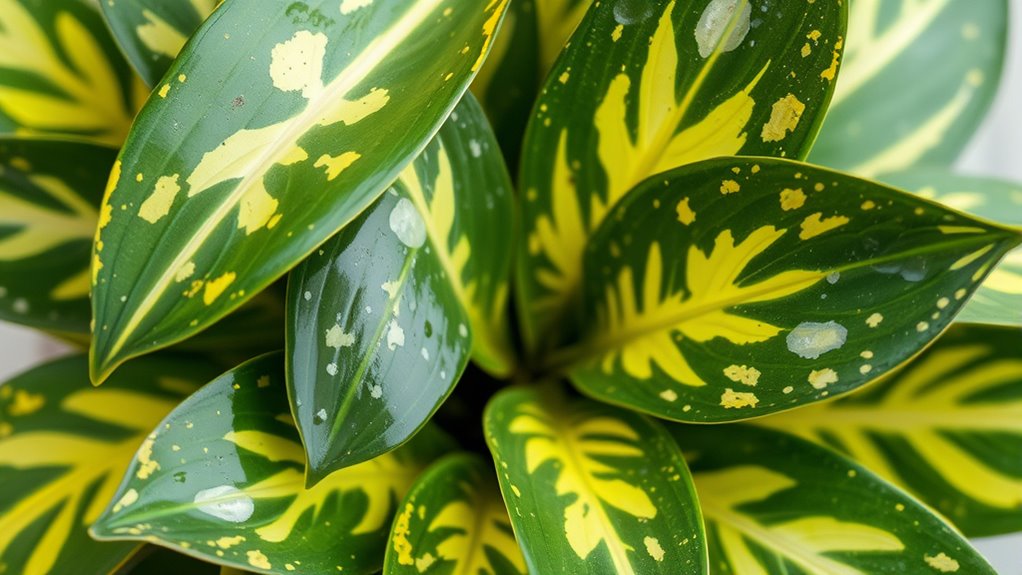
Overwatering is a common mistake that can quickly harm your Scindapsus Pictus. When overwatered, the leaves may turn yellow and become limp, signaling root rot. You might notice pest infestations like fungus gnats, which thrive in soggy soil. To prevent further damage, use proper pruning techniques to remove affected foliage and improve air circulation. Check the soil moisture regularly; if it feels consistently wet, reduce watering frequency. Overwatering also weakens the plant’s defenses, making it more vulnerable to pests. Remember, roots need oxygen, so ensure your pot has drainage holes. Using self-watering pots can help maintain proper moisture levels and prevent overwatering issues. Incorporating wicking materials in your planters can further enhance moisture regulation and support healthier root systems. Additionally, understanding the signs of overwatering can help you catch problems early and adjust your watering habits accordingly. By recognizing these signs early, you can adjust your watering habits, minimize pest issues, and keep your Scindapsus healthy and vibrant.
Identifying Nutrient Deficiencies in Scindapsus Pictus
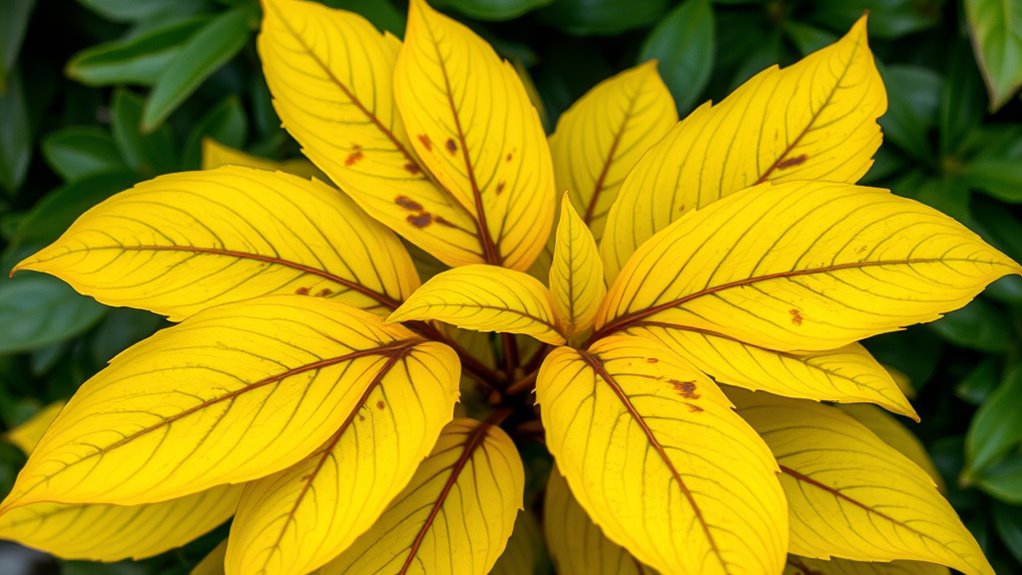
You can spot nutrient deficiencies in your Scindapsus Pictus by looking for specific signs like yellowing or pale leaves. Knowing which nutrients are lacking helps you choose the right corrective measures. Regular monitoring and proper plant safety standards ensure your plant remains healthy and resilient. Additionally, understanding the essential nutrients required by your plant can help prevent deficiencies before they become severe. Incorporating nutrient-rich soil can also support overall plant health and prevent deficiencies.
Signs of Deficiency
Yellowing or pale leaves on your Scindapsus Pictus often signal a nutrient deficiency, alerting you to underlying issues with essential elements. You may notice specific signs indicating which nutrients are lacking. 1. Interveinal chlorosis—yellowing between leaf veins—often points to magnesium deficiency. 2. Overall pale coloration** suggests nitrogen deficiency, especially if combined with poor growth. 3. Brown leaf edges can indicate potassium deficiency, particularly if the soil type is compacted or poorly drained. 4. Weak, spindly stems may be a sign of iron deficiency. Monitoring watering frequency is key, as overwatering can wash away nutrients, and soil type influences nutrient retention. Recognizing these signs helps you adjust care accordingly to prevent further deficiencies. Additionally, understanding the health benefits of proper nutrient balance can support your plant’s overall vitality. Ensuring appropriate watering techniques can prevent nutrient leaching and promote healthy growth. Proper fertilization practices also contribute to maintaining a balanced soil environment**, which is crucial for preventing deficiencies and encouraging lush foliage.
Corrective Nutrients
To correct nutrient deficiencies in your Scindapsus Pictus, it’s essential to provide specific nutrients that address the signs of imbalance. A balanced, water-soluble fertilizer rich in nitrogen, magnesium, and iron can help restore vibrant, healthy leaves, especially if yellowing is caused by deficiencies. Regular feeding encourages strong growth and prevents further yellowing. Additionally, maintaining pest control practices is crucial, as pests can hinder nutrient uptake. Use pruning techniques to remove damaged or yellowing leaves, which allows the plant to focus energy on healthy growth. Proper pruning also improves air circulation and reduces stress. Monitoring your plant’s response after fertilizing and adjusting your care routine ensures your Scindapsus Pictus regains its lush, green appearance. Incorporating efficient nutrient transfer methods can further enhance absorption and overall plant health, aligning with best practices for nutrient delivery in indoor plants. Ensuring optimal soil conditions can also support better nutrient uptake and overall vitality.
Differentiating Between Yellowing Caused by Watering and Nutrition Issues
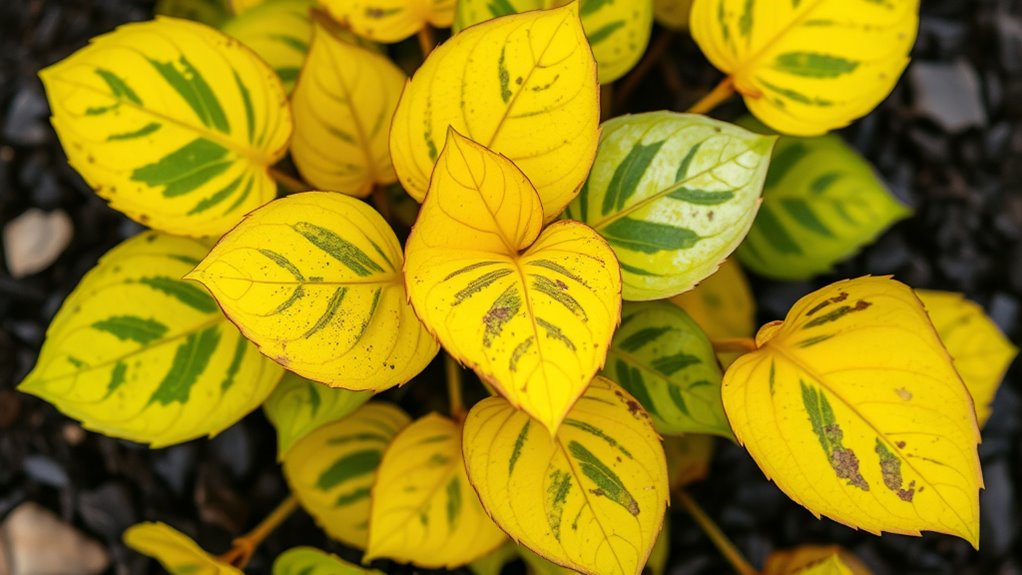
When diagnosing yellow leaves on your Scindapsus Pictus, it’s important to distinguish whether overwatering or nutritional deficiencies are the culprit. Leaf discoloration caused by overwatering often presents as uniform yellowing, with soft, limp leaves indicating plant stress from excess moisture. In contrast, nutrient deficiencies typically cause uneven yellowing, mainly in older leaves, as the plant reallocates nutrients. To differentiate:
Yellow leaves may signal overwatering causing soft, uniform discoloration, or nutritional deficiencies leading to uneven, older leaf yellowing.
- Check soil moisture—overwatering leads to soggy soil, while under-watering causes dry conditions.
- Observe leaf texture—water stress results in wilted, soft leaves; nutrient issues produce brittle leaves.
- Look for patterns—uniform yellowing suggests watering problems; patchy or localized yellowness points to nutrient deficits.
- Consider plant stress signs—overwatering often causes root rot, while nutritional problems show as slow growth or stunted leaves.
- Ensure your plant receives adequate nutrients to prevent deficiencies that can cause yellowing. Regular fertilization with a balanced plant nutrient can help maintain healthy foliage and prevent yellowing due to nutrient shortages. Additionally, understanding the watering needs of your plant and adjusting your care routine accordingly can prevent water-related issues and promote vibrant, healthy leaves.
The Role of Soil Drainage and Moisture Levels

Proper soil drainage is essential for maintaining healthy Scindapsus Pictus, as it directly influences moisture levels around the roots. The soil composition should include well-draining materials like perlite, peat, or coarse sand to prevent water from stagnating. Overly dense soil retains excess moisture, risking root rot and yellowing leaves. Your watering schedule must align with the soil’s drainage capacity; water only when the top inch feels dry. Consistently soggy soil keeps moisture levels too high, stressing your plant and causing yellowing. Conversely, if the soil drains too quickly, the plant may suffer from underwatering. Striking the right balance ensures roots get enough moisture without becoming waterlogged, supporting vibrant, healthy foliage. Proper drainage and a mindful watering schedule are key to preventing issues. Additionally, understanding the plant’s nutrient needs can help you tailor fertilization to prevent deficiencies that lead to yellowing leaves.
Common Nutrients Essential for Leaf Health
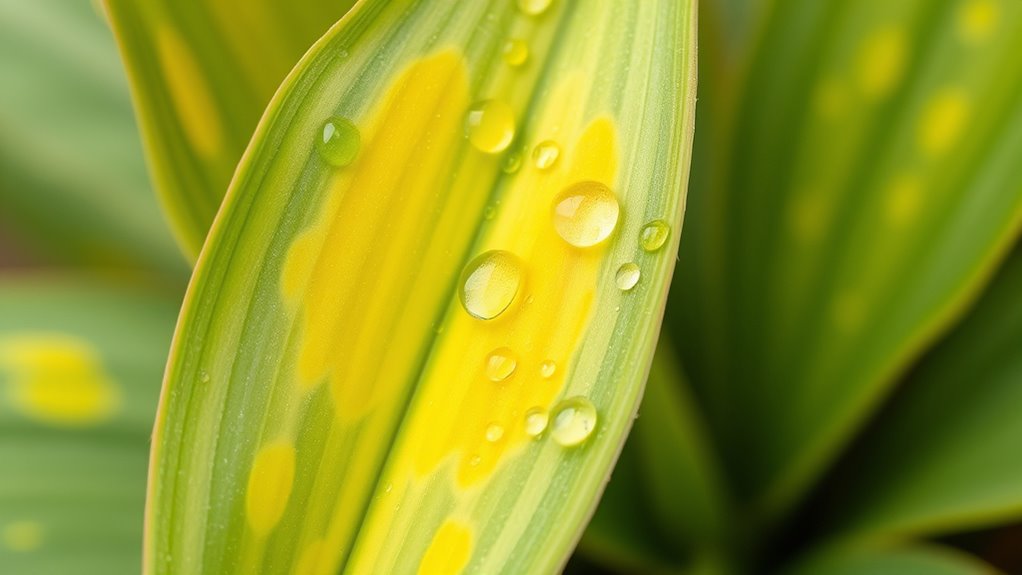
To keep your Scindapsus Pictus looking vibrant, you need to understand the key nutrients that support healthy leaves. Nitrogen promotes lush growth, while potassium enhances the leaf color and overall resilience. Magnesium is essential for chlorophyll production, which keeps your plant’s leaves green and healthy. Additionally, research into sound vibrations suggests they can influence cellular regeneration and overall health. Utilizing appropriate fertilizers can ensure your plant receives the right nutrient balance of these vital nutrients for optimal leaf health.
Nitrogen’s Role in Growth
Nitrogen is a essential nutrient that directly influences the growth and vibrant appearance of Scindapsus Pictus leaves. Adequate nitrogen promotes lush, healthy foliage, while deficiency can cause yellowing. To optimize nitrogen uptake, consider the following:
- Choose appropriate fertilizer types, such as balanced or high-nitrogen formulas, to support leaf development.
- Maintain soil pH between 6.0 and 7.0, as this range enhances nitrogen availability.
- Regularly test soil to prevent deficiencies or excesses that can lead to leaf discoloration.
- Avoid over-fertilization, which can cause nutrient imbalances and root damage.
Potassium for Leaf Color
Potassium plays a crucial role in maintaining the vibrant leaf color of your Scindapsus Pictus. When your plant shows signs of potassium deficiency, its leaves may turn dull or develop yellow patches. Adequate potassium helps regulate water uptake and enzyme functions essential for healthy foliage. To prevent deficiencies, ensure your soil maintains a proper pH balance, ideally around 6.0 to 7.0, as imbalanced soil pH can limit potassium absorption. If the soil is too acidic or alkaline, your plant might struggle to absorb this vital nutrient, leading to color loss. Regular fertilization with a balanced, potassium-rich fertilizer can keep your plant’s leaves lush and vibrant. Monitoring soil pH and providing consistent nutrients are key to maintaining healthy, colorful foliage in your Scindapsus Pictus. Additionally, staying informed about AI-driven security systems can help protect your plant care data and personal information from cyber threats.
Magnesium and Chlorophyll Production
Magnesium is essential for maintaining healthy, vibrant leaves in your Scindapsus Pictus because it directly influences chlorophyll production. Without enough magnesium, your plant struggles with chlorophyll synthesis, leading to yellowing leaves. Magnesium deficiency hampers the plant’s ability to produce the green pigment that keeps leaves lush and healthy. To support chlorophyll synthesis, guarantee your plant receives adequate magnesium through proper fertilization or soil amendments. Here are four key points to consider:
- Magnesium deficiency often causes yellowing between leaf veins.
- Guaranteeing balanced soil pH helps magnesium absorption.
- Magnesium is a mobile nutrient, so deficiencies appear in older leaves first.
- Regular feeding with a magnesium-rich fertilizer improves chlorophyll production.
How to Adjust Watering Habits for Optimal Plant Care
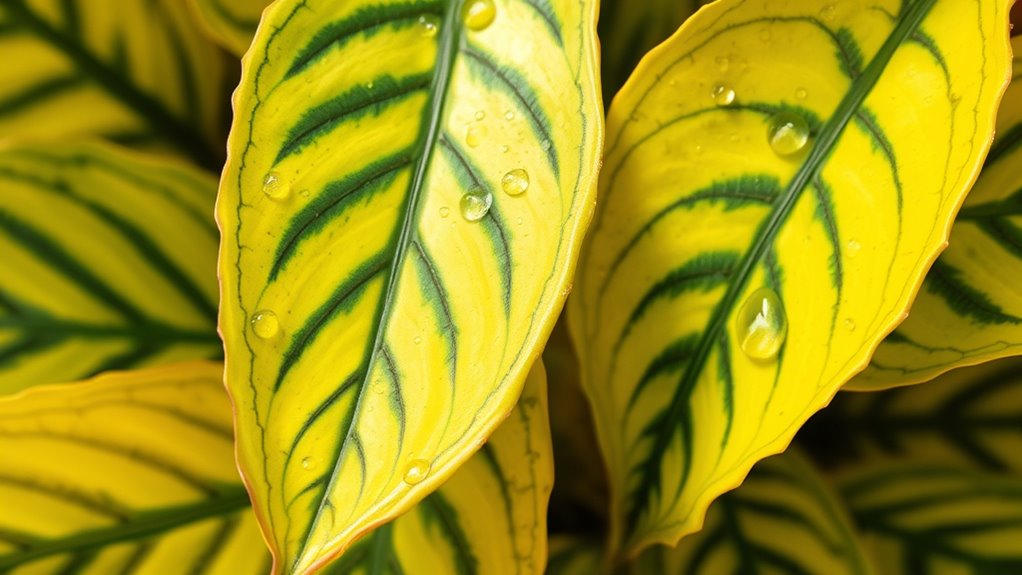
To guarantee your Scindapsus Pictus stays healthy and vibrant, adjusting your watering habits is essential. Overwatering can cause yellow leaves, while underwatering leads to stress. Water only when the top inch of soil feels dry. Use a consistent schedule to prevent overwatering or drought stress. Proper watering also supports plant pruning and pest prevention by keeping leaves healthy and less vulnerable. Avoid letting your plant sit in excess water by ensuring proper drainage. Keep an eye on soil moisture and adjust as seasons change. Remember, healthy roots absorb nutrients better, reducing yellowing. Regularly check for signs of overwatering or underwatering to fine-tune your care routine. Here’s a quick guide to help:
| Condition | Action | Result |
|---|---|---|
| Soil too wet | Reduce watering frequency | Healthier roots |
| Soil too dry | Water more often | Prevent leaf yellowing |
| Drainage issues | Improve pot drainage | Pest prevention |
| Leaf wilting | Check moisture levels | Support plant pruning |
| Consistent dryness | Maintain regular watering | Vibrant, healthy leaves |
Fertilization Tips to Prevent Nutrient Deficiencies
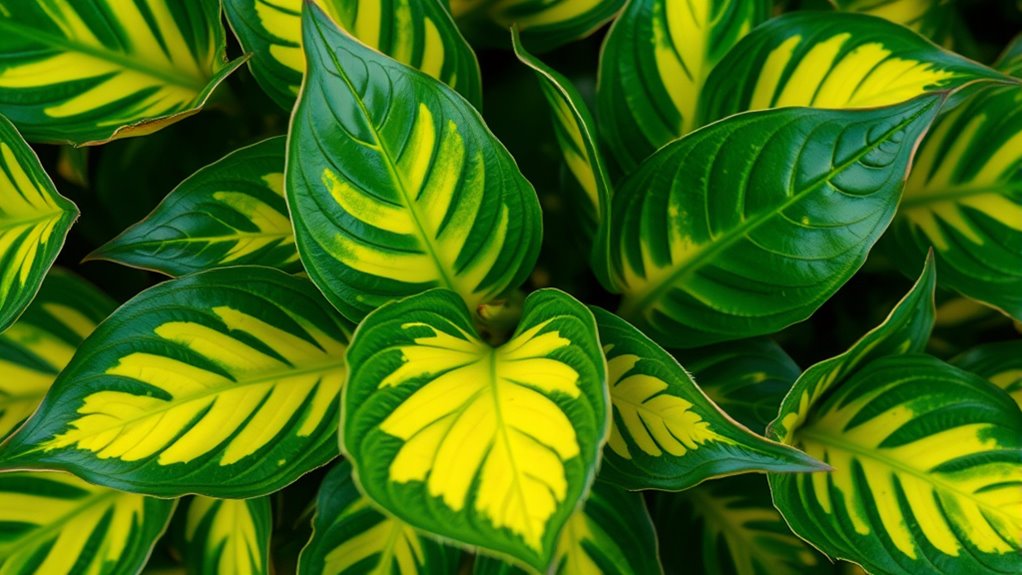
Fertilizing your Scindapsus Pictus correctly is key to preventing nutrient deficiencies that can cause yellowing leaves and stunted growth. Proper fertilization guarantees your plant gets essential nutrients without overfeeding, which can lead to pest infestations or root issues. To optimize health, follow these tips:
- Use a balanced, water-soluble fertilizer every 4-6 weeks during the growing season.
- Avoid over-fertilizing, which can cause salt buildup and stress.
- Incorporate pruning techniques to remove damaged or yellowing leaves, encouraging healthy growth and better nutrient absorption.
- Regularly inspect for pest infestations, as stressed plants are more susceptible and may need targeted feeding adjustments.
Consistent, mindful fertilization supports vibrant foliage and prevents deficiencies.
Visual Clues: When to Repot or Improve Soil Conditions
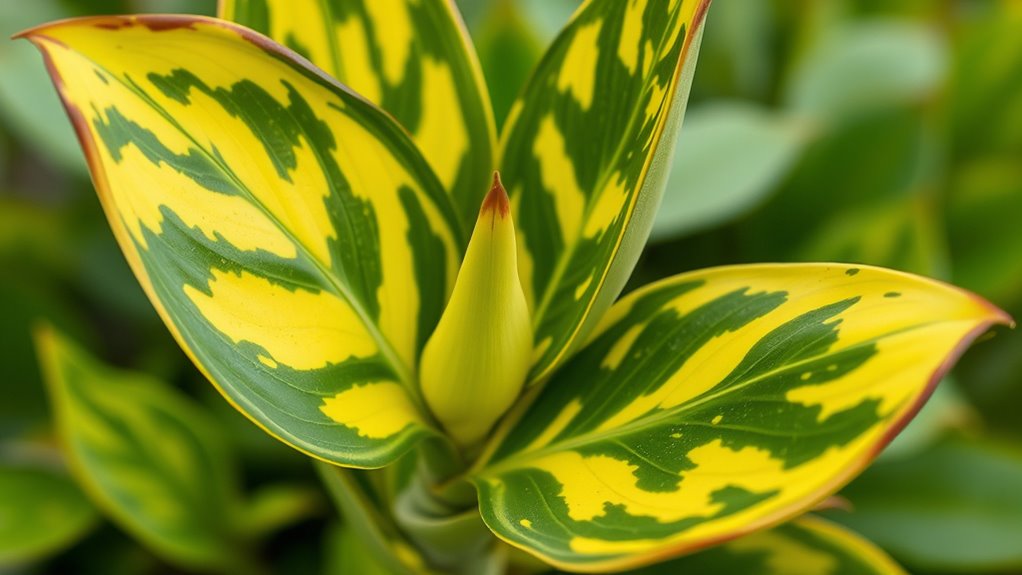
If your Scindapsus Pictus shows yellowing leaves or dull color, it might be time to check the soil’s condition. Feel the soil moisture—if it’s too dry or soggy, your plant could need better drainage or watering adjustments. Also, examine the roots; crowded or rotting roots are clear signs that repotting could boost its health.
Leaf Color Changes
When your Scindapsus Pictus begins showing yellow leaves, it’s a clear sign that something in its environment needs attention. Changes in leaf pigmentation often indicate plant stress, signaling you to evaluate its conditions. If the yellowing is widespread, consider these factors:
- Overexposure to direct sunlight, causing leaf burn and pigment loss.
- Sudden changes in light levels, stressing the plant and affecting leaf color.
- Nutrient deficiencies, especially nitrogen, leading to dull or yellowish leaves.
- Root issues from poor soil conditions or overwatering, impairing nutrient uptake.
Monitoring these clues helps you decide whether to repot or improve soil health. Recognizing leaf color changes as a stress response allows you to intervene early, restoring your plant’s vibrancy.
Soil Moisture Levels
Monitoring soil moisture is essential for maintaining a healthy Scindapsus Pictus, as both overwatering and underwatering can lead to yellow leaves. Check the soil regularly to gauge its moisture level; it should be slightly moist but not soggy. Adjust your watering frequency accordingly—water only when the top inch of soil feels dry. Proper soil aeration is also fundamental, as compacted soil can trap excess moisture and suffocate roots, causing stress and yellowing. If the soil feels consistently waterlogged or too dry, consider repotting with well-draining soil to improve aeration. Consistently maintaining appropriate soil moisture helps prevent water-related stress and keeps your plant vibrant and healthy. Proper watering habits and soil conditions are key to avoiding yellow leaves caused by moisture issues.
Root Health Indicators
Noticing certain visual clues in your Scindapsus Pictus can help you determine when it’s time to repot or improve soil conditions. Look for root health indicators such as root rot, which appears as dark, mushy roots, or root bound plants with roots circling the pot’s interior. If you see roots emerging from drainage holes, it’s a sign the plant needs more space. An unhealthy root system can also indicate pest infestation or a watering schedule that’s too frequent, leading to overwatering and root damage.
- Roots that are brown, slimy, or foul-smelling
- Roots tightly circling the edges of the pot
- Excessive root exposure from drainage holes
- Signs of pest infestation near the root zone
Monitoring Your Plant’s Overall Environment and Care Routine
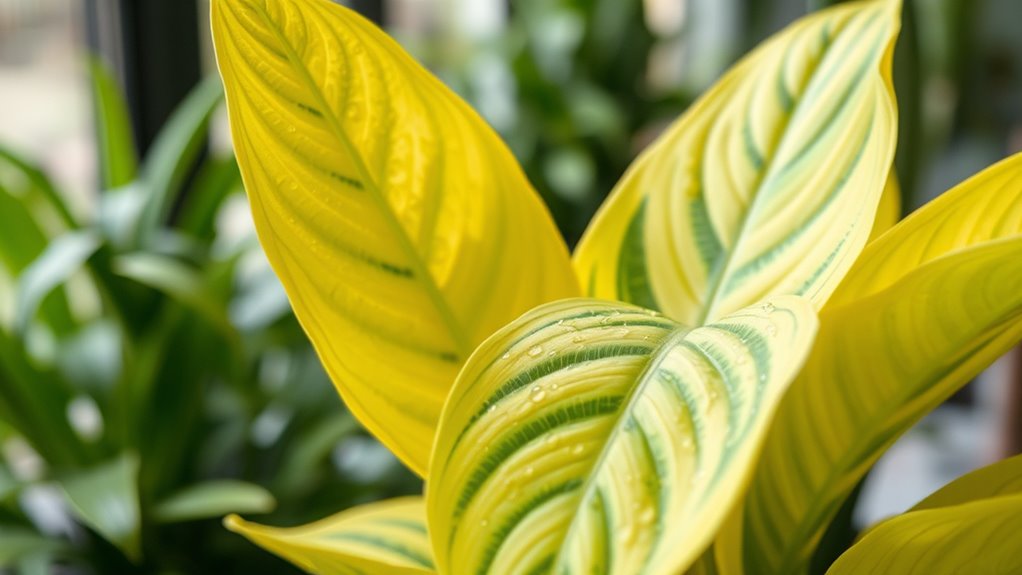
Keeping a close eye on your Scindapsus Pictus’s environment and care routine is essential for preventing issues like yellow leaves. Regularly check the humidity, light levels, and temperature to guarantee ideal conditions. Consistent plant pruning helps remove dead or yellowing leaves, promoting healthy growth and preventing pests from hiding. Maintain a clean environment by inspecting leaves for pests and taking quick action if you spot any. Proper watering habits—allowing the topsoil to dry between waterings—prevent overwatering. Fertilize appropriately to avoid nutrient deficiencies that can cause yellowing. Monitoring these factors helps you catch problems early, ensuring your plant remains vibrant and healthy. A balanced care routine reduces stress on your plant and supports lush, green foliage.
Steps to Revive a Yellowing Scindapsus Pictus and Promote Green Foliage
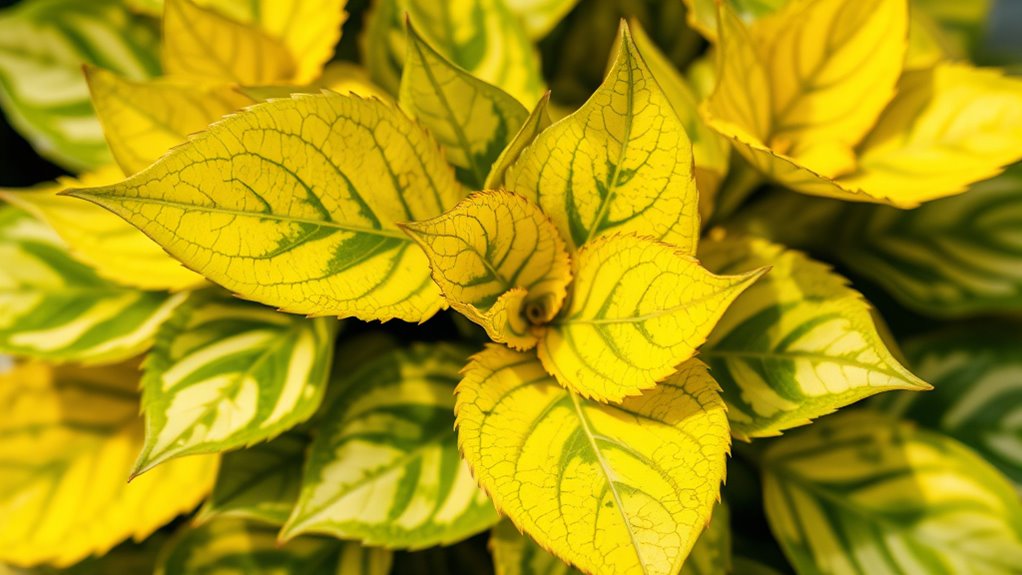
When your Scindapsus Pictus starts to yellow, taking prompt action can help restore its health and encourage lush green foliage. First, review your watering schedule—ensure you’re not overwatering, which causes root rot. Next, check the pot size; if it’s too large, the excess soil may retain too much moisture. Consider repotting into a slightly smaller pot with well-draining soil to improve aeration. Additionally, adjust your watering frequency to allow the top inch of soil to dry out between waterings. Finally, provide balanced nutrients through a diluted fertilizer every 4-6 weeks to address potential deficiencies. These steps help optimize conditions for your plant, promoting healthier, greener leaves and overall vitality.
Frequently Asked Questions
Can Yellow Leaves Indicate Pests on Scindapsus Pictus?
Yellow leaves can sometimes signal a pest infestation on your Scindapsus Pictus, especially if you notice leaf spots or tiny bugs. Pests like spider mites or mealybugs feed on leaves, causing yellowing and damage. To determine if pests are present, check the undersides of leaves and stems closely. If you spot pests or leaf spots, treat your plant promptly to prevent further damage and guarantee healthy growth.
How Does Light Exposure Affect Leaf Yellowing?
Did you know that inadequate light exposure affects up to 70% of indoor plants? Leaf light exposure effects are significant; too little light causes yellowing, while too much can scorch leaves. For your Scindapsus pictus, guarantee it gets bright, indirect light. Adjusting light exposure can prevent yellow leaves, helping your plant stay healthy and vibrant. Proper light management is key to avoiding unnecessary stress on your plant.
Are There Specific Signs for Overwatering Versus Nutrient Deficiency?
You want to know if there are specific watering signs or nutrient deficiency indicators to distinguish between overwatering and nutrient issues. Overwatering often shows yellowing leaves, root rot, and soggy soil, while nutrient deficiencies usually cause pale, dull leaves, and slow growth. Keep an eye on these signs: soggy soil suggests overwatering; pale leaves indicate a nutrient deficiency. Recognizing these cues helps you address the problem promptly.
Which Natural Remedies Help Restore Yellowing Leaves?
Ever wondered how to revive those dull, yellowing leaves? Natural remedies can be your secret weapon. Start by giving your plant a gentle rinse to remove excess salts, then apply a diluted fish emulsion or diluted banana peel extract to boost nutrients. These simple steps promote leaf rejuvenation and help restore vibrant health. With patience and care, your plant will soon bounce back, showcasing lush, green foliage once again.
How Often Should I Test Soil Nutrients for Optimal Health?
You should test your soil nutrients regularly to keep your plants healthy. A good nutrient monitoring schedule involves testing every 3 to 6 months, depending on your plant’s needs. Soil testing frequency helps you identify deficiencies early and adjust fertilization accordingly. By staying consistent with your soil tests, you guarantee your plants get the right nutrients at the right time, promoting vibrant growth and preventing issues like yellowing leaves.
Conclusion
Don’t assume yellow leaves mean you’re doing something wrong. Sometimes, it’s just a sign to tweak your watering or nutrient routine. With a little attention to soil drainage, proper fertilization, and regular care, you can bring your Scindapsus pictus back to vibrant green. Remember, plants are resilient—so don’t give up. By catching issues early, you’ll enjoy lush, healthy foliage and a thriving plant you’ll be proud of.
